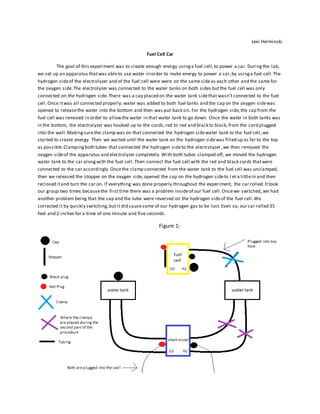
FuelCellCarLabReport
- 1. Lexi Helminski Fuel Cell Car The goal of this experiment was to create enough energy usinga fuel cell,to power a car. Duringthe lab, we set up an apparatus thatwas ableto use water in order to make energy to power a car,by usinga fuel cell.The hydrogen sideof the electrolyzer and of the fuel cell were were on the same sideas each other and the same for the oxygen side.The electrolyzer was connected to the water tanks on both sides butthe fuel cell was only connected on the hydrogen side.There was a cap placed on the water tank sidethat wasn’t connected to the fuel cell.Once itwas all connected properly, water was added to both fuel tanks and the cap on the oxygen sidewas opened to releasethe water into the bottom and then was put back on. For the hydrogen side,the cap from the fuel cell was removed in order to allowthe water in that water tank to go down. Once the water in both tanks was in the bottom, the electrolyzer was hooked up to the cords,red to red and black to black,from the cord plugged into the wall.Makingsurethe clamp was on that connected the hydrogen sidewater tank to the fuel cell,we started to create energy. Then we waited until the water tank on the hydrogen sidewas filled up as far to the top as possible.Clampingboth tubes that connected the hydrogen sideto the electrolyzer, we then removed the oxygen sideof the apparatus and electrolyzer completely. With both tubes clamped off, we moved the hydrogen water tank to the car alongwith the fuel cell.Then connect the fuel cell with the red and black cords thatwere connected to the car accordingly.Oncethe clamp connected from the water tank to the fuel cell was unclamped, then we released the stopper on the oxygen side,opened the cap on the hydrogen sideto l et a littlein and then reclosed itand turn the car on. If everything was done properly throughout the experiment, the car rolled.Ittook our group two times becausethe firsttime there was a problem insideof our fuel cell.Oncewe switched, we had another problem being that the cap and the tube were reversed on the hydrogen sideof the fuel cell.We corrected it by quickly switching,butit did causesome of our hydrogen gas to be lost.Even so, our car rolled 35 feet and 2 inches for a time of one minute and five seconds. Figure 1:
- 2. Figure 2: The picture above shows how the apparatus should behooked up with the fuel cell actually on the car already. The cords are put into the electrolyzer which is then plugged into the wall. The clamp is in the tube from the tank on the hydrogen side to the fuel cell and water is starting to rise while it is creating energy. Figure 3: The clamp should be on the entire time the fuel cell is creating energy. In the future, fuel cell-powered vehicles arepredicted to become more popular than electric vehicles.This could happen becauseusingelectricity is a way to usenatural resources that we can’t renew and water is way more abundantthan fossil fuels.Also,this would lower the amount of pollution becausethe cars would be running basically off of water, or from the sun. Hydrogen has no end to the amount of availability also so itwould be easily accessible.The problem is though, people worry about the costof the vehiclebeing too high and what would happen if for some reason the hydrogen tank would come into contactwith oxygen. There would be a huge explosion so there is a risk thatitwould take in order to use the abundantnatural resourceof hydrogen that we have.